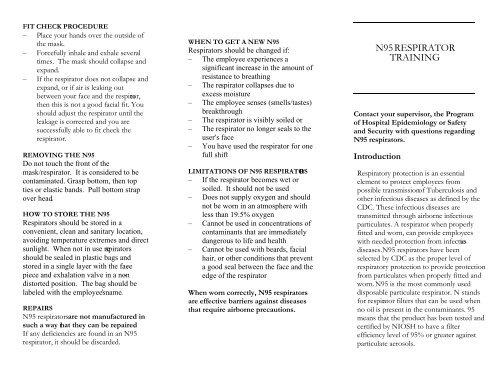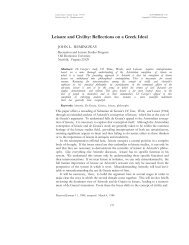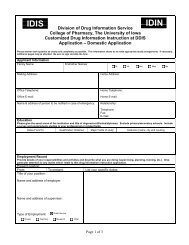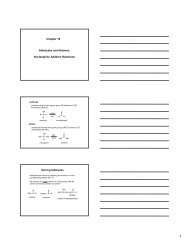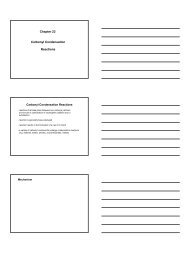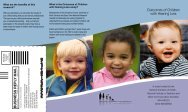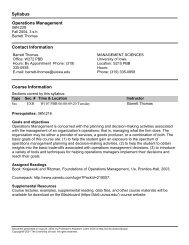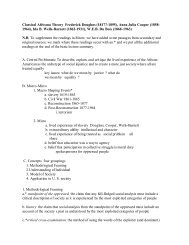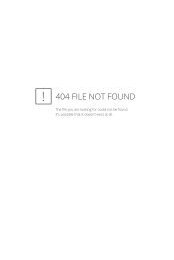N95 RESPIRATOR TRAINING
N95 RESPIRATOR TRAINING
N95 RESPIRATOR TRAINING
You also want an ePaper? Increase the reach of your titles
YUMPU automatically turns print PDFs into web optimized ePapers that Google loves.
FIT CHECK PROCEDURE<br />
– Place your hands over the outside of<br />
the mask.<br />
– Forcefully inhale and exhale several<br />
times. The mask should collapse and<br />
expand.<br />
– If the respirator does not collapse and<br />
expand, or if air is leaking out<br />
between your face and the respira tor,<br />
then this is not a good facial fit. You<br />
should adjust the respirator until the<br />
leakage is corrected and you are<br />
successfully able to fit check the<br />
respirator.<br />
REMOVING THE <strong>N95</strong><br />
Do not touch the front of the<br />
mask/respirator. It is considered to be<br />
contaminated. Grasp bottom, then top<br />
ties or elastic bands. Pull bottom strap<br />
over head.<br />
HOW TO STORE THE <strong>N95</strong><br />
Respirators should be stored in a<br />
convenient, clean and sanitary location,<br />
avoiding temperature extremes and direct<br />
sunlight. When not in use respirators<br />
should be sealed in plastic bags and<br />
stored in a single layer with the face -<br />
piece and exhalation valve in a non -<br />
distorted position. The bag should be<br />
labeled with the employees’ name.<br />
REPAIRS<br />
<strong>N95</strong> respirators are not manufactured in<br />
such a way that they can be repaired.<br />
If any deficiencies are found in an <strong>N95</strong><br />
respirator, it should be discarded.<br />
WHEN TO GET A NEW <strong>N95</strong><br />
Respirators should be changed if:<br />
– The employee experiences a<br />
significant increase in the amount of<br />
resistance to breathing<br />
– The respirator collapses due to<br />
excess moisture<br />
– The employee senses (smells/tastes)<br />
breakthrough<br />
– The respirator is visibly soiled or<br />
– The respirator no longer seals to the<br />
user’s face<br />
– You have used the respirator for one<br />
full shift<br />
LIMITATIONS OF <strong>N95</strong> <strong>RESPIRATOR</strong>S<br />
– If the respirator becomes wet or<br />
soiled. It should not be used<br />
– Does not supply oxygen and should<br />
not be worn in an atmosphere with<br />
less than 19.5% oxygen<br />
– Cannot be used in concentrations of<br />
contaminants that are immediately<br />
dangerous to life and health<br />
– Cannot be used with beards, facial<br />
hair, or other conditions that prevent<br />
a good seal between the face and the<br />
edge of the respirator<br />
When worn correctly, <strong>N95</strong> respirators<br />
are effective barriers against diseases<br />
that require airborne precautions.<br />
<strong>N95</strong> <strong>RESPIRATOR</strong><br />
<strong>TRAINING</strong><br />
Contact your supervisor, the Program<br />
of Hospital Epidemiology or Safety<br />
and Security with questions regarding<br />
<strong>N95</strong> respirators.<br />
Introduction<br />
Respiratory protection is an essential<br />
element to protect employees from<br />
possible transmission of Tuberculosis and<br />
other infectious diseases as defined by the<br />
CDC. These infectious diseases are<br />
transmitted through airborne infectious<br />
particulates. A respirator when properly<br />
fitted and worn, can provide employees<br />
with needed protection from infectious<br />
diseases. <strong>N95</strong> respirators have been<br />
selected by CDC as the proper level of<br />
respiratory protection to provide protection<br />
from particulates when properly fitted and<br />
worn. <strong>N95</strong> is the most commonly used<br />
disposable particulate respirator. N stands<br />
for respirator filters that can be used when<br />
no oil is present in the contaminants. 95<br />
means that the product has been tested and<br />
certified by NIOSH to have a filter<br />
efficiency level of 95% or greater against<br />
particulate aerosols.
BEFORE YOU WEAR AN 95… N<br />
Prior to wearing a respirator and employee<br />
must have<br />
– Medical screening to determine if an<br />
employee is physically able to wear a<br />
respirator<br />
– Fit testing to see if the respirator fits<br />
properly on the employee’s face. This<br />
must also be done annually<br />
– Initial training on the selection, use,<br />
storage and limitations of the<br />
respirator used. This should be<br />
repeated annually.<br />
WHEN SHOULD I WEAR AN <strong>N95</strong>…<br />
An <strong>N95</strong> respirator is to be worn when<br />
working in areas that have diseases that<br />
require airborne precautions. Some<br />
examples include: TB, chickenpox,<br />
measles, rubeola, SARS, smallpox, etc. For<br />
further details please refer to the Infection<br />
Control Manual Policies #300A—<br />
Overview of Isolation Precua tions and<br />
#300B—Table Specifying Isolation<br />
Precautions for Specific Diseases and<br />
Syndromes<br />
<strong>RESPIRATOR</strong> EFFECTIVENESS<br />
Respirators are only effective when the seal<br />
around your nose and mouth is tight. If<br />
you cannot achieve proper fit, do not enter<br />
the isolation or treatment area. Consult<br />
your supervisor. A respirator cannot be<br />
worn by healthcare workers with facial hair<br />
that comes between the sealing surface of<br />
the mask and face. Bearded healthcare<br />
workers should contact their supervisor to<br />
obtain information on alternative<br />
respiratory protection.<br />
TYPES OF <strong>N95</strong> UIHC <strong>RESPIRATOR</strong>S<br />
There are 2 basic types of approved <strong>N95</strong><br />
respirators used here:<br />
– Molded respirators-these respirators<br />
have a hard, molded body<br />
– Surgical mask type-these respirators<br />
are more similar to the surgical<br />
masks. Make sure they are <strong>N95</strong><br />
respirators and not just surgical<br />
masks. Normal surgical masks are<br />
not certified as protective against<br />
airborne diseases.<br />
DONNING A MOLDED <strong>N95</strong><br />
<strong>RESPIRATOR</strong><br />
Inspect the respirator (if there are any<br />
deficiencies, DISCARD the respirator )<br />
– Check the face-piece for cuts, tears,<br />
frays or loss of elasticity<br />
– Check for damaged or missing<br />
hardware<br />
– Check the elasticity of the headbands<br />
Don the respirator<br />
– Cup the respirator in your hand with<br />
the nosepiece at your fingertips<br />
– Position the respirator under your<br />
chin with the nosepiece up<br />
– Pull the top strap over your head so it<br />
rests high on the back of your head<br />
– Pull the bottom strap over your head<br />
and position it around neck below<br />
your ears.<br />
– Using two hands, mold the nosepiece<br />
to the shape of your nose. Using one<br />
hand may result in a less effective<br />
respirator seal.<br />
DONNING A SURGICAL <strong>N95</strong><br />
<strong>RESPIRATOR</strong><br />
Inspect the respirator (if there are any<br />
deficiencies, discard the respirator)<br />
– Check the face-piece for cuts, tears,<br />
frays or loss of elasticity<br />
– Check for damaged or missing<br />
hardware<br />
– Check the elasticity of the headbands<br />
Don the respirator<br />
– Separate the edges of the respirator to<br />
fully open it.<br />
– Slightly bend the nose wire to form a<br />
gentle curve.<br />
– Hold the respirator upside down to<br />
expose the two headbands.<br />
– While holding the headbands with<br />
your index fingers and thumbs, cup<br />
the respirator under your chin.<br />
– Pull headbands up over your head.<br />
– Release the lower headband from<br />
your thumbs and position it at the<br />
base of your neck.<br />
– Position the remaining headband on<br />
the crown of your head.<br />
– Conform the nosepiece across the<br />
bridge of your nose by firmly pressing<br />
down with your fingers.<br />
– Continue to adjust the respirator and<br />
secure the edges until you feel you<br />
have achieved a good facial fit


